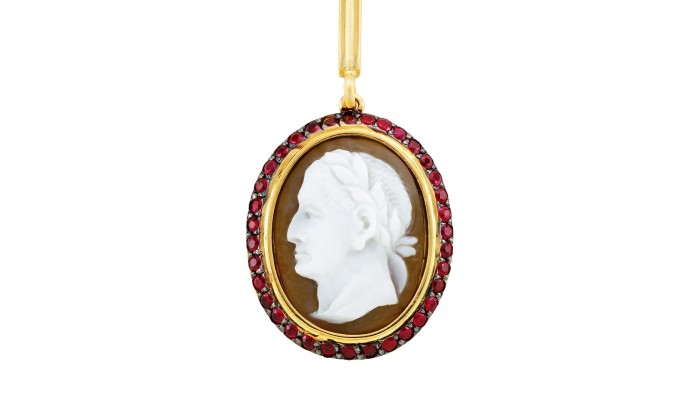Unlock the Editor’s Digest for free
Roula Khalaf, Editor of the FT, selects her favourite stories in this weekly newsletter.
A sardonyx cameo of a Grecian god, framed in diamonds and set on a deep red silk cord, caught the eyes of many at Bvlgari’s recent London exhibition of its Heritage Collection. The necklace dates from 1984, but the cameo is far older.
Equally memorable is an important enamel and cameo brooch by Charles Duron, circa 1860, featuring a beautiful neoclassical female silhouette surrounded by a brightly decorated enamel frame from London antiques dealer Bentley & Skinner, while another antiques specialist, Hancocks, has a late Georgian necklace with 12 meticulously carved onyx cameos of the Olympian gods interspersed with turquoise cabochons.
These are collectors’ pieces from the Georgian and Victorian era when the popularity of cameos was at its height. It is the thoughtful craftsmanship and mythological references that make them true collector’s pieces, says Amy Burton, creative director at Hancocks. “Ancient history captivates imaginations as much now as it has ever done,” she says.
Cameos are intriguing for their history, craftsmanship and storytelling, and are attracting a fresh wave of jewellery designers, including Sabine Roemer, Ana Katarina and Grainne Morton, as well as storied jewellers such as Mellerio in Paris, founded in 1613.
Mellerio has reintroduced cameos to its range as pendant charms that can be attached to gold chain or beaded necklaces. The designs from its Cabinet of Curiosities collection are inspired by a bracelet back in its possession that it made for Marie Antoinette, featuring a series of cameos with the silhouettes of Roman emperors.
“Cameos have a significant potential for a revival,” says Laure-Isabelle Mellerio, chief executive and creative director. “By blending their historical charm with modern design sensibilities, jewellers can create pieces that resonate with a new generation of consumer,” she adds, pointing out the resurgence of interest in vintage and antique styles across fashion and jewellery, and deeming them miniature works of art.
London-based Roemer says that in a market filled with mass-produced jewellery “this rare craftsmanship stands out, capturing attention through its authenticity”. Roemer discovered a pair of shell cameos at a gemstone fair and was captivated by their intricacy of craftsmanship and precision. They were hand-carved by gemstone cutters in Idar-Oberstein, Germany, an area rich in gemstone-carving artistry. She has updated the pair, featuring a Grecian beauty, with a frame of diamonds and a citrine frill to enhance their natural earthy hues.
These, like Mellerio’s — whose pieces were hand-carved in Torre del Greco, a village near Naples famed for this ancestral skill — are in shell. However, Roemer also uses sardonyx carving a lot, pointing out that there is “a long-standing tradition in Germany and Austria of using sardonyx intaglios [the reverse of the cameo] intricately engraved with family crests which are heirloom pieces typically gifted to children on their 18th birthday as a symbol of heritage and personal legacy.”
In Boston, Ana-Katarina Vinkler-Petrovic, a former war correspondent in Bosnia, has long been drawn to the beauty of cameos but designs her own, rather than sourcing antique pieces, as there is an enthusiastic market for her contemporary designs. Her cameos are romantic and celebrate family, ranging from a pair of lovers to the tree of life.
“I send my sketches to our master carver in Idar-Oberstein, who is a fourth-generation carver and a single mother,” says Vinkler-Petrovic. All the Ana Katarina cameos are sustainably sourced blue agate, she says, explaining how “the deeper you carve the agate, the darker the material [with] the range of colours from white to very dark black greys. This helps to elevate the design from the stone.”
There is an increasing understanding and interest in the history, craftsmanship and narrative in jewellery, and cameos fit the mould, much like intaglios. Hardstone cameos in agate and sardonyx for brooches and rings are in demand from collectors, says Ilias Kapsalis, manager of Bentley & Skinner. They are deemed more valuable than shell cameos, but even though “both types showcase incredible craftsmanship, hardstone cameos are considered more valuable due to material quality, durability and historical significance”, he says. The hardness of the stone also means they take longer and require more skill to complete.
Antique dealers, fairs and specialists are valuable sources for cameos. In Edinburgh, for instance, Morton amasses an eclectic mix of small precious objects and gemstones including shell cameos from these places that she assembles into storytelling chandelier earrings and necklaces for a meaningful but more fashionable look.
For the serious collectors it is the Victorian and Georgian cameos that are most popular, especially examples from the mid to late 19th century. “The neoclassical style, which was influenced by earlier Georgian and Renaissance designs, remains a favourite,” says Kapsalis, adding that the preferred subjects “are those of classical mythology such as Greco-Roman gods and goddesses, female profiles and high-relief carvings with dramatic colour contrasts between the different layers of the stone”.
Read the full article here

